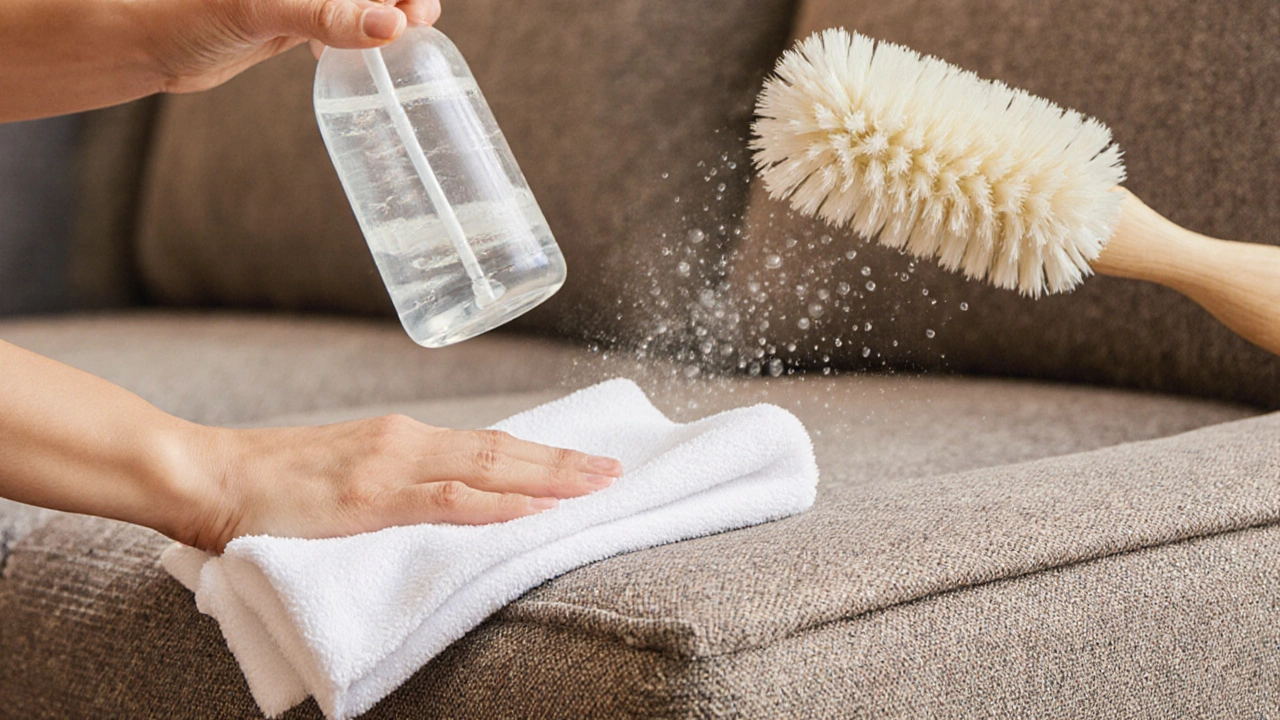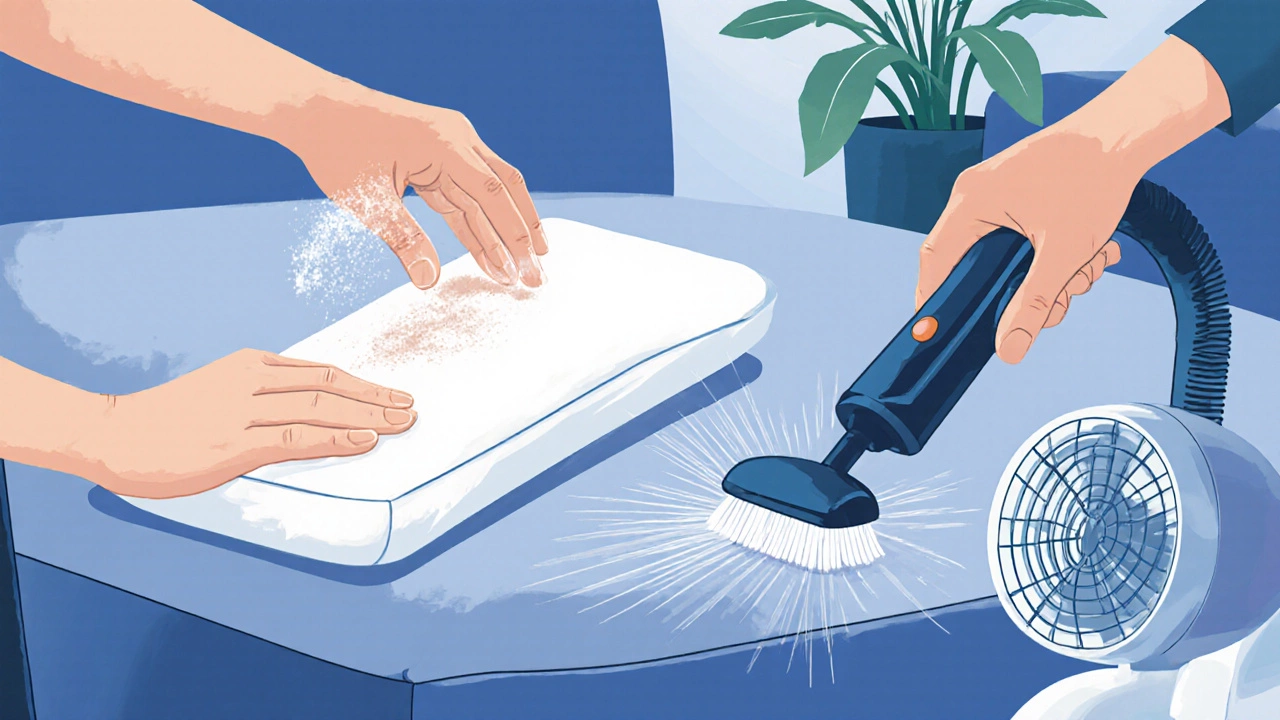Fabric Sofa Stain Finder
Stain & Fabric Selector
Select your stain type and fabric care label to get a customized cleaning solution
Recommended Solution
Got a spill on your favourite spot and wonder if you should call a pro or just roll up your sleeves? Fabric sofa is a type of upholstered furniture covered with cloth material, commonly found in living rooms and used for seating. It’s comfy, looks good, but it also loves to attract crumbs, pet hair and the occasional wine splash. The good news? You can bring back its fresh look with a few household items and a systematic approach. Below is a step‑by‑step guide that works for most fabric types, plus extra tricks for stubborn stains.
What You’ll Need Before You Start
- Vacuum cleaner with a brush attachment - to lift loose debris.
- Soft‑bristled upholstery brush - for gentle agitation.
- Clean white microfiber cloths - they won’t leave lint.
- Baking soda - natural deodoriser.
- White vinegar - mild acid for grease.
- Liquid dish soap (pH‑neutral) - safe for most fabrics.
- Spray bottle, bucket, and warm water.
- Optional: Steam cleaner for deep sanitising.
Step 1 - Clear and Vacuum
- Remove cushions, blankets and any loose items.
- Set the vacuum to the lowest suction power to avoid pulling the fabric.
- Run the brush attachment slowly across the whole surface, paying extra attention to seams and crevices.
- Turn the sofa upside‑down for a minute to dislodge dust that settled underneath.
Vacuuming eliminates the bulk of dirt, so the cleaning solution can work directly on stains instead of mixing with grit.
Step 2 - Spot‑Test Your Cleaning Solution
Before you spray anything, test on a hidden corner. Mix one teaspoon of dish soap with a cup of warm water, dab a cotton swab, and wait 10 minutes. If the colour stays unchanged and the fabric feels normal, you’re good to go.
Step 3 - Homemade Cleaning Solutions
- All‑purpose cleaner: 1 tsp dish soap + 1 tsp white vinegar + 2 cups warm water. Good for everyday grime.
- Odour absorber: Sprinkle baking soda over the entire sofa, let sit 30 minutes, then vacuum.
- Grease‑buster: Mix 2 tsp dish soap with 1 tsp baking soda and a splash of warm water to form a paste.
All three are safe for most fabrics, but always double‑check the manufacturer’s tag (usually “W” - water‑based, “S” - solvent‑based, or “WS” - both).

Step 4 - The Cleaning Process
- Lightly mist the all‑purpose cleaner onto a microfiber cloth - never soak the fabric.
- Work from the outer edges toward the centre, using gentle circular motions.
- For stubborn spots, apply the grease‑buster paste directly, let it sit 5 minutes, then rub with a soft brush.
- Rinse the cloth in clean water, wring out fully, and wipe the area to remove any soap residue.
- Pat dry with a fresh cloth. If possible, place a fan nearby to speed up drying.
Avoid over‑wetting; excess moisture can cause mould or warp the frame.
Step 5 - Tackling Specific Stains
- Red wine: Blot (don’t rub) with a clean cloth, then sprinkle baking soda, let foam, and vacuum after 15 minutes.
- Pet urine: Mix equal parts white vinegar and water, spray, let sit 10 minutes, then blot dry. Follow with baking soda to neutralise odour.
- Ink: Dab a cotton ball soaked in rubbing alcohol, test first. Once the ink lifts, clean the area with the all‑purpose solution.
- Chocolate: Scrape off excess, then apply the grease‑buster paste, let sit, and gently brush.
Step 6 - Using a Steam Cleaner (Optional)
If you own a handheld steam cleaner, it can sanitise without chemicals. Fill the tank with distilled water, set the temperature to medium, and glide the nozzle a few centimetres above the fabric. Move slowly, allowing the steam to penetrate. Never hold the nozzle in one spot longer than 5 seconds - heat can scorch delicate fibres.
Step 7 - After‑Care and Maintenance
- Vacuum weekly to keep dust from embedding.
- Rotate cushions every month to promote even wear.
- Apply a thin layer of baking soda three times a year for deep odour removal.
- Use a fabric protector spray (water‑based) after a thorough clean; re‑apply every six months.
Regular upkeep reduces the need for heavy‑duty cleaning and extends the sofa’s life.

Comparison of Common Cleaning Methods
| Method | Equipment needed | Best for | Pros | Cons |
|---|---|---|---|---|
| Vacuum only | Vacuum cleaner | Routine dust removal | Quick, no chemicals | Doesn’t lift stains |
| Spot cleaning (DIY solution) | Spray bottle, cloth, mild detergent | Fresh spills, light stains | Cost‑effective, flexible | Time‑consuming for large areas |
| Steam cleaning | Steam cleaner | Deep‑seated grime, sanitising | Chemical‑free, kills bacteria | Risk of water damage if over‑used |
| Professional upholstery cleaning | Specialised equipment, solvents | Heavy stains, delicate fabrics | Expertise, warranty on work | Higher cost, need to schedule |
Quick Checklist Before You Begin
- Read the care label on your sofa.
- Gather all tools and make sure they’re clean.
- Perform a spot test in an inconspicuous area.
- Work in a well‑ventilated room.
- Have a fan or open windows for faster drying.
Troubleshooting Common Issues
- Mildew after cleaning: Reduce water usage, increase airflow, and apply a 1:1 vinegar‑water rinse.
- Colour fading: Stop using harsh chemicals; switch to pH‑neutral cleaners and avoid excessive sun exposure.
- Stubborn residue: Re‑apply the grease‑buster paste, let sit a little longer, then brush gently.
Wrap‑Up
Cleaning a fabric sofa isn’t rocket science; it just needs patience, the right tools, and a systematic plan. Follow the steps above, keep a maintenance routine, and you’ll enjoy a fresh‑looking sofa for years.
Can I use bleach on a fabric sofa?
Bleach is too harsh for most fabrics and can cause permanent yellowing or weaken fibres. Stick to mild dish soap, vinegar or a commercial upholstery cleaner labelled safe for your sofa type.
How often should I deep‑clean my sofa?
A light vacuum every week is enough for daily upkeep. Schedule a full spot‑clean or steam session every 6‑12 months, or sooner if you have pets or children.
Is it safe to use a hair dryer to speed up drying?
Yes, but keep it on a cool or warm setting and hold it at least 30 cm away. Too much heat can melt synthetic fibres.
What if the care label says ‘Dry Clean Only’?
Test any DIY solution very carefully; otherwise, it’s best to trust a professional cleaner who can handle ‘dry clean only’ fabrics.
Can I use a carpet shampooer on a sofa?
Only if the machine has an upholstery attachment and you use a low‑foam, pH‑neutral solution. Otherwise, excess water can seep into the frame.
